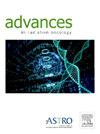Reduced Treatment Volumes for Glioblastoma Associated With Lower Rates of Radionecrosis and Lymphopenia: A Pooled Analysis
IF 2.2
Q3 ONCOLOGY
引用次数: 0
Abstract
Purpose
There is marked variability in treatment fields for glioblastoma. We performed a retrospective study comparing outcomes of patients treated according to MD Anderson Cancer Center (MDACC) or Radiation Therapy Oncology Group (RTOG) guidelines and identified differences in treatment-related toxicity.
Methods and Materials
Adult patients with glioblastoma treated with surgery and adjuvant radiation treatment were included in this study. Primary outcomes were local control, progression-free survival (PFS), overall survival (OS), and radiation-related toxicity. PFS and OS were estimated using the Kaplan-Meier estimator. Univariate and multivariate analyses were conducted using Cox regression models.
Results
In total, 257 patients met the inclusion criteria with a median age of 60.1 years at diagnosis. There were 162 and 95 patients treated according to the MDACC or RTOG guidelines, respectively. Despite having similar gross tumor volumes, the RTOG cohort had a larger median planning target volume (303.2 cm³ vs 430.7 cm³, P < .001) and worse PFS (6 months vs 9 months, P = .031). There was no difference in OS between treatment techniques. Patients treated according to RTOG guidelines experienced higher rates of radionecrosis (34% vs 21%, P = .024) and severe lymphopenia (15% vs 7%, P = .044).
Conclusions
Patients treated according to MDACC guidelines had smaller treatment volumes, improved PFS, and lower rates of radionecrosis and severe lymphopenia. However, when adjusting for prognostic factors, treatment type was not associated with PFS in multivariate analysis. Prospective investigation is warranted to confirm these differences in outcomes.
减少胶质母细胞瘤的治疗量与降低放射性坏死和淋巴细胞减少率相关:一项汇总分析
目的胶质母细胞瘤的治疗领域有明显的可变性。我们进行了一项回顾性研究,比较了根据MD安德森癌症中心(MDACC)或放射治疗肿瘤组(RTOG)指南治疗的患者的结果,并确定了治疗相关毒性的差异。方法与材料采用手术和辅助放射治疗的成年胶质母细胞瘤患者为研究对象。主要结局是局部控制、无进展生存期(PFS)、总生存期(OS)和辐射相关毒性。使用Kaplan-Meier估计器估计PFS和OS。采用Cox回归模型进行单因素和多因素分析。结果257例患者符合入选标准,诊断时中位年龄为60.1岁。根据MDACC或RTOG指南分别有162例和95例患者接受治疗。尽管大体肿瘤体积相似,RTOG队列的中位计划靶体积更大(303.2 cm³vs 430.7 cm³),P <;.001)和更差的PFS(6个月vs 9个月,P = .031)。两种治疗方法的OS无差异。根据RTOG指南治疗的患者放射性坏死(34% vs 21%, P = 0.024)和严重淋巴细胞减少(15% vs 7%, P = 0.044)的发生率更高。结论根据MDACC指南治疗的患者治疗量更小,PFS改善,放射性坏死和严重淋巴细胞减少率更低。然而,当调整预后因素时,在多变量分析中,治疗类型与PFS无关。有必要进行前瞻性调查以证实这些结果的差异。
本文章由计算机程序翻译,如有差异,请以英文原文为准。
求助全文
约1分钟内获得全文
求助全文
来源期刊

Advances in Radiation Oncology
Medicine-Radiology, Nuclear Medicine and Imaging
CiteScore
4.60
自引率
4.30%
发文量
208
审稿时长
98 days
期刊介绍:
The purpose of Advances is to provide information for clinicians who use radiation therapy by publishing: Clinical trial reports and reanalyses. Basic science original reports. Manuscripts examining health services research, comparative and cost effectiveness research, and systematic reviews. Case reports documenting unusual problems and solutions. High quality multi and single institutional series, as well as other novel retrospective hypothesis generating series. Timely critical reviews on important topics in radiation oncology, such as side effects. Articles reporting the natural history of disease and patterns of failure, particularly as they relate to treatment volume delineation. Articles on safety and quality in radiation therapy. Essays on clinical experience. Articles on practice transformation in radiation oncology, in particular: Aspects of health policy that may impact the future practice of radiation oncology. How information technology, such as data analytics and systems innovations, will change radiation oncology practice. Articles on imaging as they relate to radiation therapy treatment.
 求助内容:
求助内容: 应助结果提醒方式:
应助结果提醒方式:


